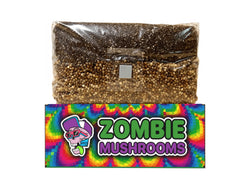- 🦠 Turkey tail mushrooms contain polysaccharopeptides (PSP & PSK), which have been studied for their immune-boosting and cancer-fighting properties.
- 🌳 These mushrooms grow naturally on decaying hardwood logs, particularly in temperate forests during autumn and spring.
- 🍄 Cultivating turkey tail mushrooms at home is possible using grow kits, hardwood logs, or indoor cultivation techniques.
- 🍵 Turkey tail mushrooms are commonly consumed as teas, tinctures, or powdered supplements due to their tough texture.
- ⚠️ People with autoimmune conditions or on immune-modulating medications should consult a healthcare provider before consuming turkey tail mushrooms.

How to Identify Turkey Tail Mushrooms
Turkey tail mushrooms (Trametes versicolor) are widely known for their distinctive appearance, making them relatively easy to identify with the right knowledge. However, they do have toxic lookalikes, so it's important to be cautious.
Identification Features:
- Fan-Shaped Fruiting Body: These mushrooms grow in a thin, semi-circular shape, often stacked in layers.
- Coloration: The characteristic concentric rings display vibrant colors such as brown, blue, orange, gray, and even green due to algae growth over time.
- Velvety Surface: The upper surface has a soft, velvety texture that sets turkey tails apart from some lookalikes.
- Pores Underneath: The underside of true turkey tail mushrooms features tiny, tightly packed pores—never gills.
- Growth Pattern: They grow in overlapping clusters on dead or decaying hardwood, particularly oak, maple, and birch.
Common Lookalikes:
- False Turkey Tail (Stereum ostrea): This resembles turkey tail mushrooms but lacks pores underneath and is not considered medicinal.
- Violet Toothed Polypore (Trichaptum biforme): Has a similar growth pattern but appears more purple and has tooth-like structures instead of pores.
To ensure proper identification, always cross-reference with images or seek expert confirmation.

Where to Find Turkey Tail Mushrooms in the Wild
Turkey tail mushrooms are widespread across North America, Europe, and Asia. They flourish in humid, shaded environments, often found in woodlands and forests with abundant decaying logs.
Best Locations to Search:
- Fallen Hardwood Trees: Turkey tails primarily grow on hardwood logs like oak, maple, and birch.
- Rotting Stumps: Tree stumps in advanced decay stages provide a perfect environment for turkey tail growth.
- Dead Branches: Keep an eye on fallen branches, especially in damp and shaded areas.
Best Seasons for Foraging:
While turkey tails can be found year-round due to their hardy nature, they tend to fruit most abundantly during:
- Autumn (Fall): Cooler, moist conditions favor their growth and brighten their color rings.
- Spring: They often persist from winter and can still be harvested.
Foraging Tips:
- Pick Responsibly: Harvest only what you need, leaving some for wildlife and continued spore spread.
- Avoid Polluted Areas: Do not forage near roadsides, industrial sites, or sprayed agricultural land.
- Check Substrate Condition: Select mushrooms from non-toxic, organic sources for safe consumption.

How to Grow Turkey Tail Mushrooms at Home
Turkey tail mushrooms are relatively easy to cultivate at home, making them an excellent choice for both beginners and experienced mushroom growers.
Choosing a Growing Method:
- Grow Kits (Beginner-Friendly): Pre-inoculated kits allow easy at-home cultivation with minimal setup.
- Hardwood Logs (Traditional Method): Requires patience but offers sustainable, repeated harvests over time.
- Indoor Substrate Cultivation (Advanced): Involves creating a controlled environment using sterilized sawdust or grain-based spawn.
Step-by-Step Cultivation Guide:
1. Selecting the Growing Medium
Turkey tail mushrooms thrive on:
- Hardwood Logs: Oak, maple, birch, and beech are ideal. Logs should be freshly cut and free of pesticides or chemicals.
- Sawdust or Straw-Based Substrate: A faster-growing option suitable for indoor setups using bags or bins.
2. Inoculating the Substrate
- For Logs: Drill holes, insert spore plugs, and seal with wax. Keep in a shaded outdoor area.
- For Indoor Substrate: Mix the substrate with turkey tail spawn and maintain moisture.
3. Colonization Period
- Logs: Expect full colonization within 6-12 months, depending on environmental conditions.
- Indoor Bags: Usually take 2-4 months for complete mycelial takeover.
4. Inducing Fruiting Conditions
- Moisture: Regular misting helps maintain high humidity.
- Airflow and Light: Indirect sunlight and good ventilation encourage healthy growth.
- Temperature: Ideal fruiting temperatures range from 55-75°F (13-24°C).
5. Harvesting Turkey Tail Mushrooms
- Harvest by cutting clusters at the base when they’re firm and brightly colored.
- Dry mushrooms immediately for long-term storage or direct medicinal use.

Medicinal and Nutritional Benefits of Turkey Tail Mushrooms
Turkey tail mushrooms have been used in traditional medicine for centuries and are now gaining attention in scientific research. Their bioactive compounds offer numerous health benefits, particularly in immune function and gut health.
Key Health Benefits:
1. Immune System Support
- Contains Polysaccharopeptides (PSP & PSK), known to enhance immune response and used as an adjunct cancer therapy in Japan and China.
- May help bolster the body’s natural defense against infections and diseases.
2. Powerful Antioxidants
- Rich in flavonoids and phenols that reduce oxidative stress.
- May contribute to longevity and overall cellular health.
3. Supports Gut Health
- Functions as a prebiotic, nourishing beneficial gut bacteria.
- May improve digestion and balance microbiome composition.
4. Potential Anti-Cancer Effects
- Several studies suggest PSK (polysaccharide-K) can slow tumor growth and improve chemotherapy outcomes.
- Widely researched as a complementary therapy in oncology.

How to Prepare and Consume Turkey Tail Mushrooms
Turkey tail mushrooms are not typically eaten like culinary mushrooms because of their tough texture. Instead, they are prepared in various extracts and supplements.
1. Turkey Tail Mushroom Tea
- Cut dried turkey tails into small pieces.
- Simmer in water for 1-2 hours to extract beneficial compounds.
- Strain and consume as a daily immune-supporting tea.
2. Tinctures and Liquid Extracts
- Double-extraction (both alcohol and water-based extractions) ensures a full range of medicinal compounds.
- Can be conveniently added to drinks or taken as a daily supplement.
3. Powdered Supplements
- Dried turkey tails can be powdered and encapsulated for easy daily consumption.
- Can be mixed into smoothies, soups, or baked goods.

Safety Considerations and Side Effects
Turkey tail mushrooms are generally considered safe but should be consumed with awareness of potential effects.
- Autoimmune Conditions: As an immune stimulator, it may exacerbate conditions like lupus or multiple sclerosis.
- Medication Interactions: Consult a doctor if taking immunosuppressants or undergoing chemotherapy.
- Allergic Reactions: Rare, but individuals with mold or fungal allergies should be cautious.
FAQs
How can you identify turkey tail mushrooms correctly?
They have a fan shape, concentric color bands, a velvety texture, and small pores underneath.
Where are turkey tail mushrooms commonly found?
They grow on decaying hardwood logs in temperate forests, especially in fall and spring.
How do you grow turkey tail mushrooms at home?
You can cultivate them using grow kits, hardwood logs, or indoor grain spawn methods.
What are the medicinal and nutritional benefits of turkey tail mushrooms?
They support the immune system, promote gut health, and have antioxidant and anti-inflammatory properties.
How can you cook or prepare turkey tail mushrooms for consumption?
They are best consumed as tea, tinctures, or powdered supplements.
Citations
Guggenheim, A. G., & Wright, K. M. (2020). Immune Modulatory and Anti-Cancer Properties of Trametes versicolor. Journal of Fungi, 6(3), 135.




